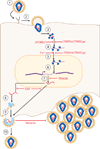Host restriction factors blocking retroviral replication
- PMID: 18624631
- PMCID: PMC3598625
- DOI: 10.1146/annurev.genet.42.110807.091704
Host restriction factors blocking retroviral replication
Abstract
Retroviruses are highly successful intracellular parasites, and as such they are found in nearly all branches of life. Some are relatively benign, but many are highly pathogenic and can cause either acute or chronic diseases. Therefore, there is tremendous selective pressure on the host to prevent retroviral replication, and for this reason cells have evolved a variety of restriction factors that act to inhibit or block the viruses. This review is a survey of the best-characterized restriction factors capable of inhibiting retroviral replication and aims to highlight the diversity of strategies used for this task.
Figures

References
-
- Abudu A, Takaori-Kondo A, Izumi T, Shirakawa K, Kobayashi M, et al. Murine retrovirus escapes from murine APOBEC3 via two distinct novel mechanisms. Curr. Biol. 2006;16:1565–1570. - PubMed
-
- Alce TM, Popik W. APOBEC3G is incorporated into virus-like particles by a direct interaction with HIV-1 Gag nucleocapsid protein. J. Biol. Chem. 2004;279:34083–34086. - PubMed
Publication types
MeSH terms
Substances
Grants and funding
LinkOut - more resources
Full Text Sources
Other Literature Sources

